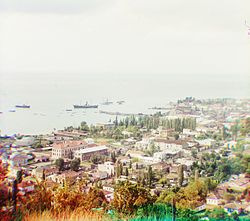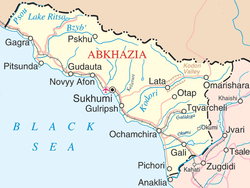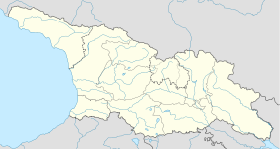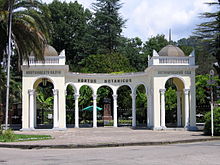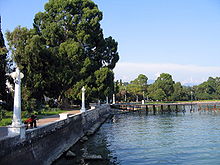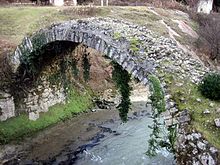- Sukhumi
-
This article is about the Abkhazian capital. For the city in Ghana, see Suhum, Ghana.
Sukhumi
Аҟәа, სოხუმი, Сухум/Сухуми
Akwa, Sokhumi, Sukhum/Sukhumi
Seallocation of Sukhumi within Abkhazia Location of Sukhumi in Georgia Coordinates: 43°00′12″N 41°00′55″E / 43.00333°N 41.01528°E Partially recognized country Abkhazia Government - Mayor Alias Labakhua[1] Elevation 5-140 m (-454 ft) Population (2010) - Total 39,100 Time zone MSK (UTC+3) Postal code Area code(s) +995 44хххххх Sukhumi (Abkhaz: Аҟәа, Aqwa; Georgian: სოხუმი, Sokhumi; Russian: Сухум or Сухуми, Sukhum or Sukhumi) is the capital of Abkhazia, a disputed region on the Black Sea coast. The city suffered heavily during the Georgian-Abkhaz conflict in the early 1990s.
Contents
Naming
In Abkhaz, the city is known as Аҟәа (Aqwa) which according to native tradition signifies water.[2] In Georgian, the city is known as სოხუმი (Sokhumi) or აყუ (Aqu),[3] in Megrelian as აყუჯიხა (Aqujikha),[4] and in Russian as Сухум (Sukhum) or Сухуми (Sukhumi).
The etymology of the name Sokhumi is disputed. The medieval Georgian sources knew the town as Tskhumi (ცხუმი).[5][6][7] Later, under the Ottoman control, the town was known in Turkish as Suhum-Kale, which can be derived from the earlier Georgian form Tskhumi or can be read to mean 'water-sand fortress'.[8][9] Tskhumi in turn is supposed to be derived from the Svan language word for 'hot',[10] or the Georgian word for 'hornbeam tree'. The competing etymologies have been used as putative evidence in the argument over the ethnicity of Sukhumi's historical inhabitants.[citation needed]
The ending -i in the above forms represents the Georgian nominative-suffix. The town was initially officially described in Russian as Сухум (Sukhum), until 16 August 1936 when this was changed to Сухуми (Sukhumi). This remained so until 4 December 1992, when the Supreme Council of Abkhazia restored the "original" version,[11] that was approved in Russia in autumn 2008,[12] even though Сухуми is also still being used.
In English, the most common form today is Sukhumi, although Sokhumi is used as well by some sources, including Encyclopædia Britannica[13] and MSN Encarta[14]
General information
Sukhumi is located on a wide bay of the eastern coast of the Black Sea and serves as a port, rail junction and a holiday resort. It is known for its beaches, sanatoriums, mineral-water spas and semitropical climate. Sukhumi is also an important air link for Abkhazia as the Sukhumi Dranda Airport is located nearby the city. Sukhumi contains a number of small-to-medium size hotels serving chiefly the Russian tourists. Sukhumi botanical garden was established in 1840, one of the oldest botanical gardens in the Caucasus.
The city has a number of research institutes, the Abkhazian State University and the Sukhumi Branch of the Tbilisi State University (currently functioning in Tbilisi). In Soviet times, it contained a renowned ape breeding station. From 1945 to 1954 the city's electron physics laboratory was involved in the Soviet program to develop nuclear weapons.
The city is a member of the International Black Sea Club.[15]
History
The history of the city began in the mid-6th century BC when an earlier settlement of the second and early first millennia BC, frequented by local Colchian tribes, was replaced by the Milesian Greek colony of Dioscurias (Greek: Διοσκουριάς), geographically the remotest that Miletus ever established. The city is said to have been so named for the Dioscuri, the twins Castor and Pollux of classical mythology. It became busily engaged in the commerce between Greece and the indigenous tribes, importing wares from many parts of Greece, and exporting local salt and Caucasian timber, linen, and hemp. It was also a prime center of slave trade in Colchis. The city and its surroundings were remarkable for the multitude of languages spoken in its bazaars.
Although the sea made serious inroads upon the territory of Dioscurias, it continued to flourish until its conquest by Mithridates VI Eupator of Pontus in the later 2nd century. Under the Roman emperor Augustus the city assumed the name of Sebastopolis [16] (Greek: Σεβαστούπολις). But its prosperity was past, and in the 1st century Pliny the Elder described the place as virtually deserted though the town still continued to exist during the times of Arrian in the 130s.[17] The remains of towers and walls of Sebastopolis have been found underwater; on land the lowest levels so far reached by archaeologists are of the 1st and 2nd centuries AD. In 542 the Romans evacuated the town and demolished its citadel to prevent it from being captured by Sassanid Iran. In 565, however, the emperor Justinian I restored the fort and Sebastopolis continued to remain one of the Byzantine strongholds in Colchis until being sacked by the Arab conqueror Marwan II in 736.
Afterwards, the town came to be known as Tskhumi.[10] Restored by the kings of Abkhazia from the Arab devastation, it particularly flourished during Georgia’s "golden age" in the 12th-13th centuries, when Tskhumi became a center of traffic with the European maritime powers, particularly with the Republic of Genoa. The Genoese established their short-lived trading factory at Tskhumi early in the 14th century.
The Ottoman navy occupied the town in 1451, but for a short time. Later contested between the princes of Abkhazia and Mingrelia, Tskhumi finally fell to the Turks in the 1570s. The new masters heavily fortified the town and called it Sohumkale, with kale meaning "fort" but the first part of the name of disputed origin. It may represent Turkish su, "water", and kum, "sand", but is more likely to be an alteration of its earlier Georgian name.[10] At the request of the pro-Russian Abkhazian prince, the town was stormed by the Russian Marines in 1810 and turned, subsequently, into their major outpost in the North West Caucasus. Sukhumi was declared the seaport in 1847 and was directly annexed to the Russian Empire after the ruling Shervashidze princely dynasty was ousted by the Russian authorities in 1864. During the Russo-Turkish War, 1877–1878, the town was temporarily controlled by the Ottoman forces and Abkhaz-Adyghe rebels.
Following the Russian Revolution of 1917, the town and Abkhazia in general were engulfed in the chaos of the Russian Civil War. A short-lived Bolshevik government was suppressed in May 1918 and Sukhumi was incorporated into the Democratic Republic of Georgia as a residence of the autonomous People's Council of Abkhazia and the headquarters of the Georgian governor-general. The Red Army and the local revolutionaries took the city from the Georgian forces on March 4, 1921, and declared Soviet rule. Sukhumi functioned as the capital of the "Union treaty" Abkhaz Soviet Socialist Republic associated with the Georgian SSR from 1921 until 1931, when it became the capital of the Abkhazian Autonomous Soviet Socialist Republic within the Georgian SSR. By 1989, Sukhumi had 110,000 inhabitants and was one of the most prosperous cities of Georgia. Many holiday dachas for Soviet leaders were situated there.
Beginning with the 1989 riots, Sukhumi was a centre of the Georgian-Abkhaz conflict, and the city was severely damaged during the 1992-1993 War. During the Abkhaz siege of Sukhumi (1992–1993), the city and its environs suffered almost daily air strikes and artillery shellings, with heavy civilian casualties.[18] On September 27, 1993 the battle for Sukhumi was concluded by a full-scale campaign of ethnic cleansing against its majority Georgian population (see Sukhumi Massacre), including members of the Abkhazian government (Zhiuli Shartava, Raul Eshba and others) and mayor of Sukhumi Guram Gabiskiria. Although the city has been relatively peaceful and partially rebuilt, it is still suffering the after-effects of the war, and it has not regained its earlier ethnic diversity. Its population in 2003 was 43,716, compared to about 120,000 in 1989.[19]
Climate
Sukhumi has a humid subtropical climate (Köppen Cfa), that is almost cool enough in summer to be an oceanic climate.
Climate data for Sukhumi Month Jan Feb Mar Apr May Jun Jul Aug Sep Oct Nov Dec Year Average high °C (°F) 8
(46)9
(48)12
(54)16
(61)19
(66)23
(73)25
(77)26
(79)23
(73)19
(66)15
(59)11
(52)17.2
(62.9)Average low °C (°F) 2
(36)2
(36)5
(41)8
(46)12
(54)17
(63)19
(66)19
(66)15
(59)11
(52)7
(45)3
(37)10.0
(50.0)Precipitation mm (inches) 137
(5.39)113
(4.45)135
(5.31)123
(4.84)115
(4.53)127
(5)100
(3.94)123
(4.84)127
(5)121
(4.76)133
(5.24)152
(5.98)1,506
(59.29)Avg. rainy days 17 15 16 15 12 11 10 10 10 12 16 16 160 Source no. 1: Weatherbase [20] Source no. 2: Georgia Travel Climate Information[21] Demographics
Historic population figures for Sukhumi, split out by ethnicity, based on population censuses:[22]
Year Abkhaz Armenians Estonians Georgians Greeks Mingrelians[23] Russians Svans [23] Turkish Ukrainians Total 1887 Census 1.8%
(144)13.5%
(1,083)0.4%
(32)11.9%
(951)14.3%
(1,143)19.0%
(1,522)21.1%
(1,685)0.0%
(1)4.0%
(323)2.7%
(216)7,998 1926 Census 3.1%
(658)9.4%
(2,023)0.3%
(63)11.2%
(2,425)10.7%
(2,298)12.1%
(2,599)23.7%
(5,104)0.1%
(12)--- 10.4%
(2,234)21,568 1939 Census 5.5%
(2,415)9.8%
(4,322)0.5%
(206)19.9%
(8,813)11.3%
(4,990)--- 41.9%
(18,580)--- --- 4.6%
(2,033)44,299 1959 Census 5.6%
(3,647)10.5%
(6,783)--- 31.1%
(20,110)4.9%
(3,141)--- 36.8%
(23,819)--- --- 4.3%
(2,756)64,730 1979 Census 9.9%
(10,766)10.9%
(11,823)--- 38.3%
(41,507)6.5%
(7,069)--- 26.4%
(28,556)--- --- 3.4%
(3,733)108,337 1989 Census 12.5%
(14,922)10.3%
(12,242)--- 41.5%
(49,460)--- --- 21.6%
(25,739)--- --- --- 119,150 2003 Census 65.3%
(24,603)12.7%
(5,565)0.1%
(65)4.0%
(1,761)1.5%
(677)0.2%
(86)16.9%
(8,902)--- --- 1.6%
(712)43,716 Main sights
Sukhumi houses a number of historical monuments, notably the Beslet arcaded bridge built during the reign of queen Tamar of Georgia in the 12th century. It also retains visible vestiges of the defunct monuments, including the Roman walls, the 11th-century castle of Bagrat III, several towers of the Great Abkhazian Wall constructed by the early modern Mingrelian and Abkhazian princes amid their territorial disputes; the 14th-century Genoese fort, and the 18th-century Ottoman fortress. The 11th century Kaman Church (12 km from Sukhumi) is erected, according to tradition, over the tomb of Saint John Chrysostom. Some 22 km from Sukhumi lies New Athos with the ruins of the medieval city of Anacopia. The Neo-Byzantine New Athos Monastery was constructed here in the 1880s on behest of Tsar Alexander III of Russia. Northward in the mountains is the Voronya Cave, the deepest in the world, with a depth of 2,140 meters.[24]
Twin towns - sister cities
See also
References
- ^ Алиас Лабахуа вступил в должность мэра столицы (Alias Labakhua takes office of the capital's mayor), 18.09.2007 (Russian)
- ^ Colarusso, John. "More Pontic: Further Etymologies between Indo-European and Northwest Caucasian". p. 54. http://www.safarmer.com/Indo-Eurasian/Pontic-horse.pdf. Retrieved 2009-08-22.
- ^ Abkhazworld.com, p. 65
- ^ Otar Kajaia, 2001–2004, Megrelian-Georgian Dictionary (entry aq'ujixa).
- ^ Vita Sanctae Ninonis. [[TITUS (project)|]] Old Georgian hagiographical and homiletic texts: Part No. 39
- ^ Martyrium David et Constantini. [[TITUS (project)|]] Old Georgian hagiographical and homiletic texts: Part No. 41
- ^ Kartlis Cxovreba: Part No. 233. [[TITUS (project)|]]
- ^ Goltz, Thomas (2009 (2006)). "4. An Abkhazian Interlude". Georga Diary (Expanded Edition ed.). Armonk, New York / London, England: M.E. Sharpe. p. 56. ISBN 978-0-7656-2416-1.
- ^ Abkhazeti.info (Russian)
- ^ a b c Room, A. (2005), Placenames of the World: Origins and Meanings of the Names for 6,600 Countries, Cities, Territories, Natural Features and Historic Sites. McFarland & Company, Inc., Publishers, Jefferson, North Carolina, and London, ISBN 0-7864-2248-3, p. 361
- ^ RRC.ge (Russian)
- ^ Абхазию и Южную Осетию на картах в РФ выкрасят в "негрузинские" цвета
- ^ "Sokhumi". (2006). In Encyclopædia Britannica. Retrieved November 6, 2006, from Encyclopædia Britannica Online: Britannica.com
- ^ "Sokhumi". (2006). In Encarta. Retrieved November 6, 2006: Encarta.msn.com
- ^ International Black Sea Club, members
- ^ Hewitt, George (1998) The Abkhazians: a handbook St. Martin's Press, New York, p. 62, ISBN 031221975X
- ^ Dioscurias. A Guide to the Ancient World, H.W. Wilson (1986). Retrieved 20 July 2006, from Xreferplus.com
- ^ "The Human Rights Watch report, March 1995 Vol. 7, No. 7". Hrw.org. http://www.hrw.org/reports/1995/Georgia2.htm. Retrieved 2010-07-04.
- ^ 2003 Census statistics (Russian)
- ^ http://www.weatherbase.com/weather/weatherall.php3?s=6273&refer=&units=metric&cityname=Sukhumi-Georgia
- ^ http://www.travel-climate.com/georgia/data.php?cit=37260
- ^ Population censuses in Abkhazia: 1886, 1926, 1939, 1959, 1970, 1979, 1989, 2003 (Russian)
- ^ a b Mingrelians and Svans, subethnic groups of Georgian people, were not distinguished from Georgians in some Soviet censuses (1939-1989)
- ^ Voronya Peshchera. Show Caves of the World. Retrieved on 2008-07-29.
- ^ "Podolsk sister cities". Translate.google.com. http://translate.google.com/translate?sourceid=navclient&hl=en&u=http%3a%2f%2fadmpodolsk.ru%2findex.php%3fcategoryid%3d126. Retrieved 2010-07-04.
External links
Coordinates: 43°00′N 41°01′E / 43°N 41.017°E
Administrative divisions of Abkhazia Districts 
Cities SukhumiTowns Other settlements Adzyubzha · Avadhara · Bedia · Bzyb · Chkhalta · Chuburkhindji · Gulripsh · Guma · Gyachrypsh · Ilori · Kvemo Barghebi · Labra · Lykhny · Myussera · Pskhu · Psou · TsandryphshSee also: Administrative divisions of Georgia Cities and towns in Georgia Autonomous Republic of Abkhazia Sokhumi · Akhali Atoni · Gagra · Gali · Gudauta · Ochamchire · Tkvarcheli · Bichvinta · Gantiadi · Gulripshi · Leselidze · Miusera.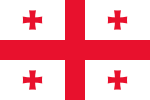
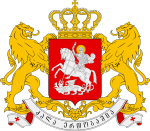
Autonomous Republic of Adjara Guria Imereti Kakheti Mtskheta-Mtianeti Samegrelo-Zemo Svaneti Samtskhe-Javakheti Akhaltsikhe · Akhalkalaki · Borjomi · Ninotsminda · Vale · Abastumani · Adigeni · Akhaldaba · Aspindza · Bakuriani · Bakurianis Andeziti · Tsagveriacha-Lechkhumi and Kvemo Svaneti Kvemo Kartli Shida Kartli Cities with local Government Capital City North Pontic Greek colonies Tyras · Olbia · Borysthenes · Eupatoria · Chersonesos · Charax · Theodosia · Kimmerikon · Nymphaion · Tyritake · Panticapaeum · Myrmekion · Kepoi · Phanagoria · Hermonassa · Gorgippia · Pityus · Dioscurias · Tanais
 Categories:
Categories:- Ancient Greek cities
- Pontic Greeks
- Sukhumi
- Milesian Pontic colonies
- Capitals in Asia
- Capitals in Europe
- Port cities in Asia
- Port cities in Europe
- Black Sea
- Greek colonies in Georgia (country)
Wikimedia Foundation. 2010.

